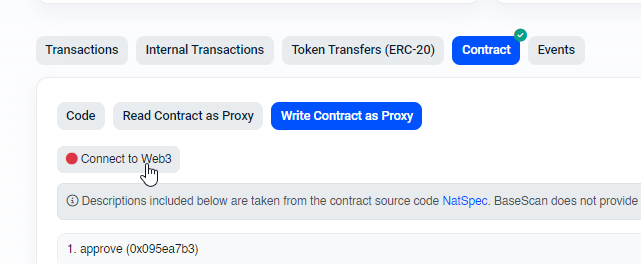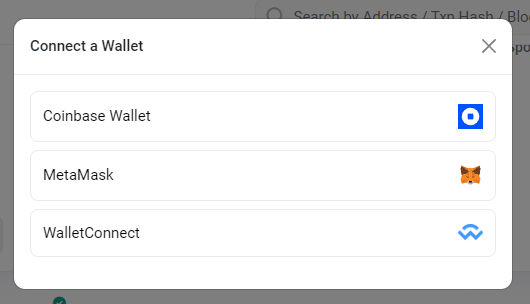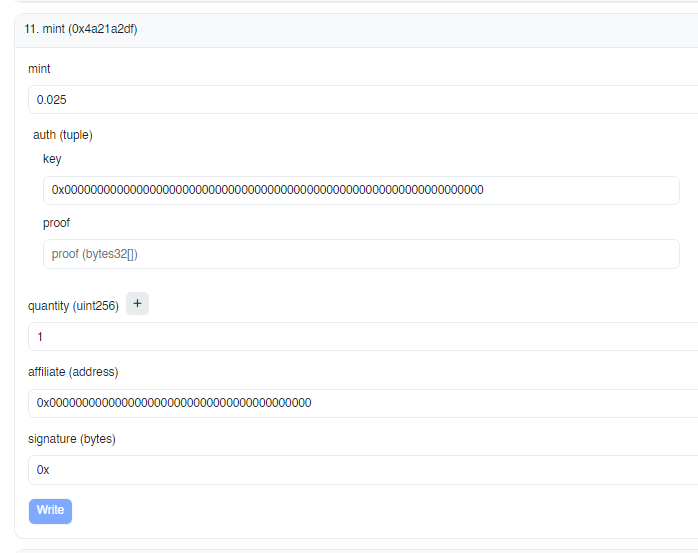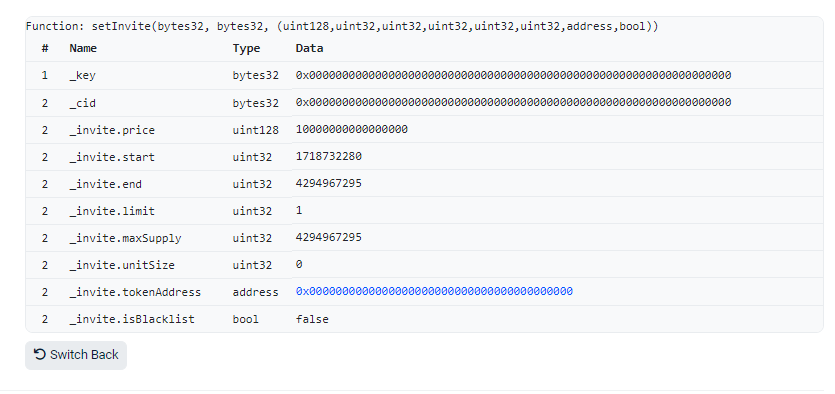Etherscan Minting
There can at times be cases where you want to mint a collection directly on Etherscan. While Scatter makes every effort to be stable during hype minting, it's always possible that it could go down from extreme demand or malicious attack while a mint is ongoing. In these cases, you can mint directly on Etherscan.
Note that as affiliate mints require Scatter to sign the transactions, you cannot mint with an affiliate address directly on Etherscan. You must use Scatter for these mints. With this in mind, the affiliate field for minting will always be:
0x0000000000000000000000000000000000000000
And the signature will always be:
0x
Please read this document fully and do not skip anything as some information is not repeated between the sections.
Step 1: Go to the Contract Page
First, you need to go to the contract page of the collection you want to mint. You can find this by going to the collection's page on Scatter and clicking the contract address. This will open the contract page to the appropriate "scan" site. For example, if the collection is on Ethereum, it will open Etherscan. For Basechain, it will open Basescan.
![]()
Step 2: Connect to the Contract

Once you're on the contract page, you'll need to connect to the contract. You can do this by clicking the "Connect to Web3" button. This will open a popup that will ask you to connect your wallet. You can typically use MetaMask, Coinbase Wallet, and WalletConnect.

Step 3: Minting
Depending on the type of list you want to mint, be it a public or private whitelist, you'll need certain information.
Public Lists
For public lists, you just need to know the list's auth key. This is typically:
0x0000000000000000000000000000000000000000000000000000000000000000
Though it is possible to be different if the collection owner has created multiple public lists. If you check the transaction history you can find the auth key for the list you want to mint by checking the list transactions and decoding their inputs. For multiple public lists, look for keys which look similar to the above but increase in value slightly.

The "payableAmount (ether)" field will always be in Ether as a unit. Multiply the amount of Ether by the number of NFTs you want to mint to get the total amount of Ether you need to send. You will need to know the price of this list to be able to do this. You can either find this on Scatter, or check the chain to find the price that was set when a list was created with the collection contract's "Set Invite" method.


When you find a price from decoding a list creation transaction, you will need to convert the value from Gwei to Ether. You can do this from this tool easily:
https://etherscan.io/unitconverter
Paste the value in Wei (10-18) and click convert to Ether (1). Then that Ether value is what you input on minting.
The decoded information can also tell you useful information such as when the list will become available time wise to mint on if you do not already know. You can post the _invite.start value into https://www.epochconverter.com/ to get a human readable date and time in your local timezone.
When you have the information in correctly, and you're sure the start time is proper, you can try to mint by clicking the "write" button and confirming the transaction with your wallet.
Note that sometimes you need to wait for the next block before you can mint if a list is on a countdown. So if you try to mint exactly when the countdown ends, you might need to wait a few seconds for the next block to be mined before you can mint. If your wallet says "this transaction is likely to fail" do not force it otherwise you may waste a transaction fee.
If your wallet says the transaction is likely to fail, it's possible you input the values incorrectly. If you want to do minting on the *scan sites, it's important that you take the time to practice minting in this way with test collections so that you're comfortable doing the process for a collection you are interested in.
Private Whitelists
For private whitelists, one requirement you need is to know the list of addressses on the private whitelist. Oekaki Connect will try to make these lists of addresses public in the case where people want to mint directly on the *scan sites. You can ask in our Discord for lists we have published. If a list is only meant for a specific group of people, we might not publish that list of addresses publicly.
Copy and paste the list of addresses into this tool:
https://webtools.scatter.art/merkle-tree-proofs/
When you click "Generate Merkle Root" this is the auth key of the list that set of addresses is for. You can then use this auth key to mint from the list.
You'll also need to generate your proof. This is done by entering your address in the correct field and clicking "Generate Proof" on the same page. This will give you a proof that you can use to mint from the list. You can only do this after you've generated the merkle root. That Scatter Webtool will also be able to show you if your address is on a list or not even if you don't have the list of addresses, you can enter the merkle root in the proper field along with your address click Verify Merkle Root to see if you are able to mint that list.
Instead of leaving the proof field blank like you would for a public list, you want to paste the proof you generated into the proof field.
Some further reading on understanding Merkle Trees and Proofs: https://medium.com/crypto-0-nite/merkle-proofs-explained-6dd429623dc5
Merkle trees as a technology is what enables it to be efficient to store and verify large lists of addresses onchain.
That's most of what you need to know to mint directly on *scan sites. If you have any questions, feel free to ask in our Discord!